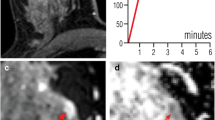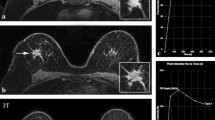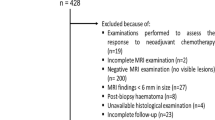Abstract
Purpose: To assess the diagnostic accuracy of contrast-enhanced 3.0-T breast magnetic resonance imaging (MRI) for differentiating benign from malignant breast masses and subsequently to test if specificity could be further improved by scoring of the overall ipsilateral breast vascularity. Materials and methods: Fifty-four patients were prospectively enrolled in the study and underwent contrast-enhanced 3.0-T breast MRI. MR images were evaluated and classified according to the MRI BI-RADS lexicon criteria. Lesion size, number of lesions, and localization in the breast were systematically assessed. Maximum intensity projections (MIPS) were obtained by using high-resolution contrast-enhanced (0.1 mmol/kg gadobutrol) fat-saturated T1-weighted images. Breast vascularization was scored according to the methods from Sardanelli et al. by measuring the number, diameter, and length of the vessels on the MIPS. The score ranged from 0 (indicating absent or low breast vascularity) to 3 (indicating high breast vascularity). Results: Final analysis of 56 lesions revealed 25 (45%) malignant lesions and 31 (55%) benign lesions. Correlation with the MRI BI-RADS classification revealed cancer in none (0%) of the BI-RADS II lesions, in 1 (12%) of the BI-RADS III lesions, in 5 (83%) of the BI-RADS IV lesions, and in 19 (100%) of the BI-RADS V lesions. Based on morphologic and kinetic data analysis, the sensitivity and specificity of 3.0-T breast MRI was 100% (25/25) and 74% (23/31), respectively. After adjustment for the breast vascularity score, specificity significantly (p = 0.048) increased to 87% (27/31) without affecting sensitivity. Conclusion: Diagnostic accuracy of contrast-enhanced 3.0-T breast MRI increased significantly when the vascularity score was added to the standard morphologic and kinetic data analysis, resulting in a specificity of 87% without affecting sensitivity, which remained 100%.


Similar content being viewed by others
References
Orel SG, Schnall MD, LiVolsi VA, Troupin RH (1994) Suspicious breast lesions: MR imaging with radiologic-pathologic correlation. Radiology 190:485–493
Sardanelli F, Iozzelli A, Fausto A (2003) MR imaging of the breast: indications, established technique and new directions. Eur Radiol 13 (Suppl 3):N28–N36
Sardanelli F, Podo F (2007) Breast MR imaging in women at high-risk of breast cancer. Is something changing in early breast cancer detection? Eur Radiol 17:873–887
Liberman L, Morris EA, Dershaw DD, Abramson AF, Tan LK (2003) MR imaging of the ipsilateral breast in women with percutaneously proven breast cancer. AJR Am J Roentgenol 180:901–910
Fischer U, Kopka L, Grabbe E (1999) Breast carcinoma: effect of preoperative contrast-enhanced MR imaging on the therapeutic approach. Radiology 213:881–888
Ikeda DM, Hylton NM, Kinkel K, Hochman MG, Kuhl CK, Kaiser WA, Weinreb JC, Smazal SF, Degani H, Viehweg P, Barclay J, Schnall MD (2001) Development, standardization, and testing of a lexicon for reporting contrast-enhanced breast magnetic resonance imaging studies. J Magn Reson Imaging 13:889–895
American College of Radiology (ACR) (2003) Breast imaging reporting and data system. Atlas BI-RADS. American College of Radiology, Reston, Va
Daniel BL, Yen YF, Glover GH, Ikeda DM, Birdwell RL, Sawyer-Glover AM, Black JW, Plevritis SK, Jeffrey SS, Herfkens RJ (1998) Breast disease: Dynamic spiral MR imaging. Radiology 209:499–509
Harms SE, Flamig DP, Hesley KL, Meiches MD, Jensen RA, Evans WP, Savino DA, Wells RV (1993) MR imaging of the breast with rotating delivery of excitation off resonance: clinical experience with pathologic correlation. Radiology 187:493–501
Boetes C, Barentsz JO, Mus RD, van der Sluis RF, van Erning LJ, Hendriks JH, Holland R, Ruys SH (1994) MR characterization of suspicious breast lesions with a gadolinium-enhanced TurboFLASH subtraction technique. Radiology 193:777–781
Stomper PC, Herman S, Klippenstein DL, Winston JS, Edge SB, Arredondo MA, Mazurchuk RV, Blumenson LE (1995) Suspect breast lesions: findings at dynamic gadolinium-enhanced MR imaging correlated with mammographic and pathologic features. Radiology 197:387–395
Bone B, Aspelin P, Bronge L, Isberg B, Perbeck L, Veress B (1996) Sensitivity and specificity of MR mammography with histopathological correlation in 250 breasts. Acta Radiol 37:208–213
Knopp MV, Weiss E, Sinn HP, Mattern J, Junkermann H, Radeleff J, Magener A, Brix G, Delorme S, Zuna I, van Kaick G (1999) Pathophysiologic basis of contrast enhancement in breast tumors. J Magn Reson Imaging 10:260–266
Lehman CD, Gatsonis C, Kuhl CK, Hendrick RE, Pisano ED, Hanna L, Peacock S, Smazal SF, Maki DD, Julian TB, DePeri ER, Bluemke DA, Schnall MD (2007) MRI Evaluation of the contralateral breast in women with recently diagnosed breast cancer. N Engl J Med 356:1295–1303
Mahfouz AE, Sherif H, Saad A, Taupitz M, Filimonow S, Kivelitz D, Hamm B (2001) Gadolinium-enhanced MR angiography of the breast: is breast cancer associated with ipsilateral higher vascularity? Eur Radiol 11:965–969
Wright H, Listinsky J, Quinn C, Rim A, Crowe J, Kim J (2005) Increased ipsilateral whole breast vascularity as measured by contrast-enhanced magnetic resonance imaging in patients with breast cancer. Am J Surg 190:576–579
Sardanelli F, Iozzelli A, Fausto A, Carriero A, Kirchin MA (2005) Gadobenate dimeglumine-enhanced MR Imaging breast vascular maps: association between invasive cancer and ipsilateral increased vascularity. Radiology 235:791–797
Carriero A, Di Credico A, mansour M, Bonomo L (2002) Maximum intensity projection analysis in magnetic resonance of the breast. J Exp Clin Cancer Res 21(3 Suppl):77–81
Hylton NM (2001) Vascularity assessment of breast lesions with gadolinium-enhanced MR Imaging. Magn Reson Imaging Clin N Am 9:321–332
Nunes LW, Schnall MD, Orel SG, Hochman MG, Langlotz CP, Reynolds CA, Torosian MH (1997) Breast MR imaging: interpretation model. Radiology 202:833–841
Hauth EA, Jaeger H, Maderwalld S, Stockamp C, Mühler A, Kimmig R, Forsting M (2006) Evaluation of quantitative parametric analysis for characterization of breast lesions in contrast-enhanced MR mammography. Eur Radiol 16:2934–2941
Kinkel K, Helbich TH, Esserman LJ, Barclay J, Schwerin EH, Sickles EA, Hylton NM (2000) Dynamic high-spatial resolution MR imaging of suspicious breast lesions: diagnostic criteria and interobserver variability. AJR Am J Roentgenol 175:35–43
Helbich TH (2000) Contrast-enhanced magnetic resonance imaging of the breast. Eur J Radiol 34:208–219
Pediconi F, Catalano C, Occhiato R, Venditti F, Fraioli F, Napoli A, Kirchin MA, Passariello R (2005) Breast lesion detection and characterization at contrast-enhanced MR mammography: gadobenate dimeglumine versus gadopentetate dimeglumine. Radiology 237:45–56
Hata T, Takahashi H, Watanabe K, Takahashi M, Taguchi K, Itoh T, Todo S (2004) Magnetic resonance imaging for preoperative evaluation of breast cancer: a comparative study with mammography and ultrasonography. J Am Coll Surg 198:190–197
Huang W, Fisher PR, Dulaimy K, Tudorica LA, O'Hea B, Button TM (2004) Detection of breast malignancy: diagnostic MR protocol for improved specificity. Radiology 232:585–591
Macura KJ, Ouwerkerk R, Jacobs MA, Bluemke DA (2006) Patterns of enhancement on breast MR images: interpretation and imaging pitfalls. Radiographics 26:1719–1734
Kuhl CK, Jost P, Morakkabati N, Zivanovic O, Schild HH, Gieseke J (2006) Contrast-enhanced MR imaging of the breast at 3.0 and 1.5T in the same patients: initial experience. Radiology 239:666–676
Pintaske J, Martirosian P, Graf H, Erb G, Lodemann KP, Claussen CD, Schick F (2006) Relaxivity of Gadopentetate Dimeglumine (Magnevist), Gadobutrol (Gadovist), and Gadobenate Dimeglumine (MultiHance) in human blood plasma at 0.2, 1.5, and 3 Tesla. Invest Radiol 41:213–221
Goyen M, Herborn CU, Vogt FM, Kroger K, Verhagen R, Yang F, Bosk S, Bebatin JF, Ruehm SG (2003) Using a 1 M Gd-chelate (gadobutrol) for totalbody three-dimensional MR angiography: preliminary experience. J Magn Reson Imaging 17:565–571
Tombach B, Heindel W (2002) Value of 1.0-M gadolinium chelates: review of preclinical and clinical data on gadobutrol. Eur Radiol 12:1550–1556
Author information
Authors and Affiliations
Corresponding author
Rights and permissions
About this article
Cite this article
Schmitz, A.C., Peters, N.H.G.M., Veldhuis, W.B. et al. Contrast-enhanced 3.0-T breast MRI for characterization of breast lesions: increased specificity by using vascular maps. Eur Radiol 18, 355–364 (2008). https://doi.org/10.1007/s00330-007-0766-z
Received:
Revised:
Accepted:
Published:
Issue Date:
DOI: https://doi.org/10.1007/s00330-007-0766-z




